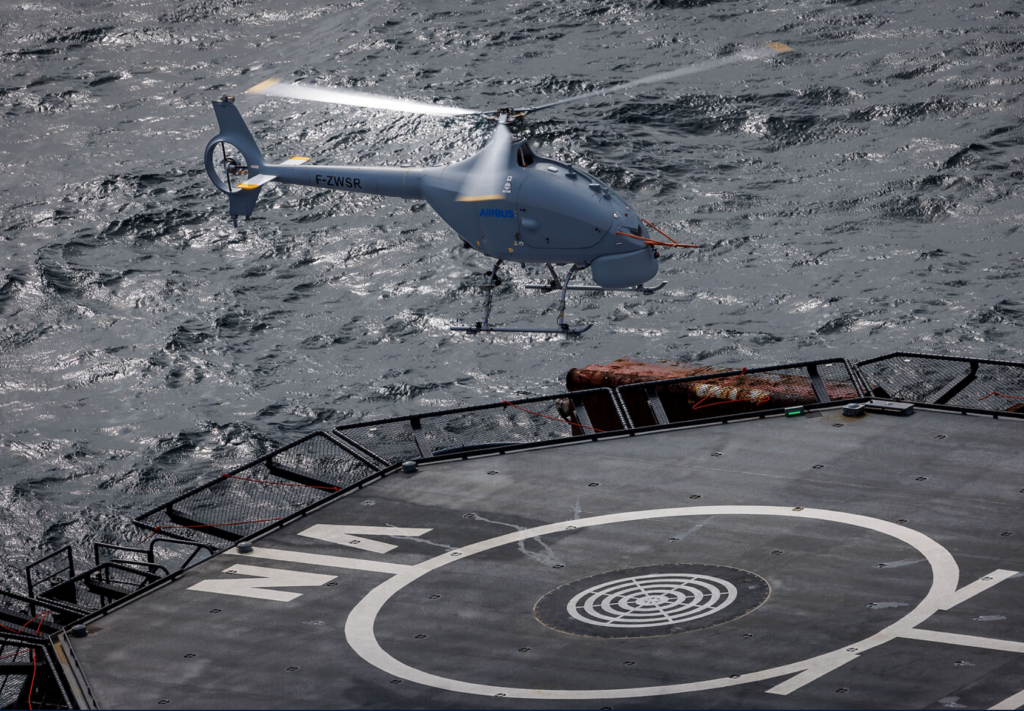
Airbus Helicopters and the French Armament General Directorate (DGA) collaborated to test the VSR700 in an operational configuration from a ship at sea for the first time. (Photo: Airbus)
Recently, the VSR700, Airbus’ unmanned aerial system (UAS), completed more testing at sea in the west of France as a part of Airbus’ collaboration with the French Armament General Directorate (DGA). Performing several autonomous take-offs and landings, the tests performed will help ensure the system is ready for certification and integration to navy fleets across the world.
In late 2020, Airbus completed a test for its VSR700 program using its automatic flight control system (AFCS), landing the aircraft on a moving platform without assistance from a pilot.
The VSR 700 is Airbus’ answer to the modern conflict and battlefields of the 21st century. The aircraft is about 6.2 meters (20.3 feet) long and 2.3 meters (7.5 feet) high, and it has a main rotor diameter of 7.2 meters (23.6 feet). The VSR700 is equipped with the Airbus DeckFinder system, allowing it to land precisely even in severe conditions. Powered by traditional jet fuel, the aircraft can operate for as long as 8 hours nonstop and its maximum take off weight of 700 kg (1,540 pounds) and ceiling of 6,000 meters (19,750 feet) make it a strong fit for a variety of missions performed at sea.
Because of its application to navies, Airbus has begun testing for the VSR700 at sea in full operational configuration. In the beginning of May 2023, the system performed a total of 80 autonomous take-offs and landings from the deck of a civil vessel outfitted with a helicopter pad. These tests took place off the coast of Brittany in northwestern France.
This testing marks significant progress for the VSR700 program. As Nicolas Delmas, the head of the VSR700 program at Airbus Helicopters, explained, “This flight test campaign was an important step for the VSR700 programme as it allowed us to validate the excellent performance of the drone in operational conditions, which were representative of its future missions. The VSR700 prototype opened its flight envelope in winds above 40 knots, accumulated eight hours of testing in 14 flights, and made successful landings in several different sea states.”
This is not the first testing performed on the VSR700. In March 2022, Airbus used the same ship and tested the system’s autonomous take-off and landing features using an optionally piloted vehicle (OPV) based on a modified Guimbal Cabri G2 aircraft.

Airbus Helicopters began trialing the VSR700’s autonomous take-off and landing capabilities at sea in 2022 using an optionally piloted vehicle (OPV) based on a modified Guimbal Cabri G2. (Photo: Airbus)
Current testing follows a series of trials performed late last year and early 2023 in collaboration with the DGA at the Levant Island test center in southern France. The two trials demonstrated the system’s reliability in real maritime settings. With all of these tests completed, Airbus’ next step for the VSR700 involves carrying out its maiden flight on board a French Navy FREMM. The company hopes to achieve this in the second half of this year.